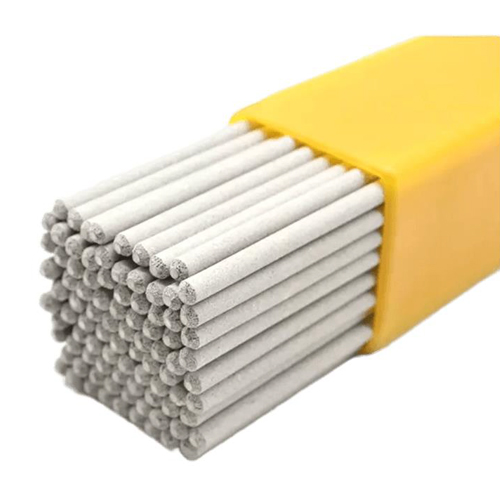

íshín-410Rx has 12 Cr as nominal composition (wt. %) of weld and is an air-hardening steel. Preheat and post heat treatments are required to achieve welds of adequate ductility for many engineering purposes. The most common application of these electrodes is for welding alloys of similar compositions. They are also used for surfacing of carbon steels to resist corrosion, erosion, or abrasion.
The covering of these electrodes is a modification of the -16 covering. On horizontal fillet welds, electrodes with a -17 covering tend to produce more of a spray arc and a finer rippled weld-bead surface than do those with the -16 coverings. A slower freezing slag of the -17 covering also permits improved handling characteristics when employing a drag technique. The bead shape on horizontal fillets is typically flat to concave with -17 covered electrodes as compared to flat to slightly convex with -16 covered electrodes. When making fillet welds in the vertical position with upward progression, the slower freezing slag of the -17 covered electrodes requires a slight weave technique to produce the proper bead shape. For this reason, the minimum leg-size fillet that can be properly made with a -17 covered electrode is larger than that for a -16 covered electrode. While these electrodes are designed for all-position operation, electrode sizes 4.8 mm and larger are not recommended for vertical or overhead welding.
Storage and Drying Conditions: Hydrogen can have adverse effects on welds in some steels under certain conditions. One source of this hydrogen is moisture in the electrode coverings. For this reason, the proper storage, treatment, and handling of electrodes are necessary.
Holding Ovens: 125°C–150°C.
Drying Conditions: 250°C–425°C for 1 hour prior to use.
CHEMICAL COMPOSITION OF UNDILUTED WELD
|
C |
Cr |
Ni |
Mo |
Nb+Ta |
Mn |
Si |
P |
S |
N |
Cu |
Others |
|
0.12 |
11.0-13.5 |
0.70 |
0.75 |
NS |
1.00 |
0.90 |
0.04 |
0.03 |
NS |
0.75 |
NS |
Single values are maxima, except where specified otherwise.
ALL-WELD-METAL MECHANICAL PROPERTIES
Heat to 730°C to 760°C, hold for one hour (–0, +15 minutes), furnace cool at a rate not to exceeding 110°C per hour to 315°C and air cool to ambient. Preheat: 200°C minimum and Interpass Temperature: 315°C maximum
|
Tensile Strength, MPa |
Yield Strength, At 0.2% Offset, MPa |
Elongation % |
Lateral Expansion, mm |
Charpy V-Notch Impact at NS°C, Joules |
|
520 |
NS |
20 |
NS |
NS |
Single values are minimal.
ELECTRODE SIZE & WELDING CURRENT (AC and DCEP)
|
DIAMETER, mm |
LENGTH, mm |
Amperes |
|
2.50 |
350 |
65-90 |
|
3.15, 3.20 |
350 |
90-120 |
|
4.00 |
350 |
120-150 |
|
5.00 |
350 |
160-200 |
WARNING: Safety and health information is available from many sources, including, but not limited to Safety and Health Fact Sheets listed in A11.3, ANSI Z49.1 Safety in Welding, Cutting, and Allied Processes published by the American Welding Society, 8669 Doral Blvd., Suite 130, Doral, FL 33166., and applicable federal and state regulations. The Safety and Health Fact Sheets are revised, and additional sheets added periodically.
